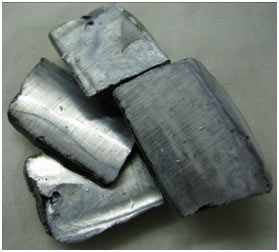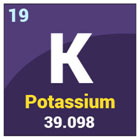Introduction
Potassium is a member of alkali metals in group 1 of the periodic table.
It is represented by the symbol K.
Potassium has 19 electrons and 19 protons.
Its atomic number is 19 and its atomic mass is 39.
Naming and History
The word potassium is from the English word “Potash”. The chemical name of potassium is from the Latin word “kalium”. Or it may be derived from the Arabic word ‘kali’ for alkali i.e., the substances that form ashes.
In 1807, Sir Humphry Davy was the first person who isolated and identified potassium as an element. It was done by electrolysis and hence the first metal isolated by this method.
He exposed the molten caustic potash and the globules of new metal were collected at the cathode.
Occurrence of Potassium
Potassium is the eighth-most abundant element on Earth. It makes about 2.1 % weight of Earth’s crust and presents as feldspars and clays. It can be found in various minerals such as sylvite, carnallite, polyhalite, and kainite.

Properties of Potassium
Potassium in its pure elemental form is a soft, waxy, and silvery-white metal that can easily be cut with a knife. When cut it oxidizes rapidly and tarnishes within minutes.
Because of highly reactive elements, they can never be found free. It reacts with oxygen to form potassium superoxide and with water to form hydroxide. The amount of heat is too much that it can explode or get fire.
It has a melting point of 63 °C which is very low for a metal and a boiling point of 770 °C. Its density is 0.89 grams per cubic centimeter which means it can float over water.
Potassium in biological Systems
Potassium is essential to life. Potassium ions are present in all cells. It is essential for keeping fluid and electrolyte balance.
Plant cells are especially abundant in potassium, which they receive from the soil. Agricultural land, from which harvests are taken every year, needs to have its potassium replenished by adding potassium-based fertilizers.
Applications
The majority of potassium (95 %) enters into fertilizers and the rest goes generally into making potassium hydroxide (KOH), by the electrolysis of the potassium chloride option, and after that transforming this to potassium carbonate (K2CO3).
Potassium forms an alloy with salt (NaK) that is utilized as a heat transfer medium in some types of atomic power plants or nuclear reactors.
Important substances of potassium consist of potassium superoxide, KO2, which is used in respiratory equipment, and potassium nitrate, used in fertilizers and pyrotechnics.
Potassium chloride (KCl) is the most common potassium compound. It is used in fertilizers, as a salt replacement, and to produce other chemicals.
Potassium hydroxide (KOH) is utilized to make soaps, cleaning agents, and drain cleaners.
Isotopes of Potassium
Potassium has three isotopes. One is 39 K, 40 K and 41 K. Potassium 40 and 41 are of great interest to scientists as these are used in research to study the effects and impacts on the growth of plants and cardiovascular systems of humans.
41 K is the radioisotope so it can also be used to determine the age of dead remains of animals and plants by calculating its half-life.
Multiple Choice Questions (MCQs) – Potassium
- What is the atomic number of potassium?
- A) 18
- B) 19
- C) 20
- D) 21
Answer: B) 19
- Who was the first person to isolate and identify potassium as an element?
- A) Marie Curie
- B) Sir Humphry Davy
- C) Dmitri Mendeleev
- D) Robert Boyle
Answer: B) Sir Humphry Davy
- What is the chemical name of potassium derived from?
- A) German word “Potenz”
- B) Latin word “kalium”
- C) Greek word “Potamos”
- D) Arabic word “kali”
Answer: B) Latin word “kalium”
- In its pure elemental form, what color does potassium exhibit?
Answer: A) Silver
- What is the melting point of potassium?
- A) 63 °C
- B) 100 °C
- C) 200 °C
- D) 500 °C
Answer: A) 63 °C
- What is the primary application of potassium in terms of percentage usage?
- A) Pharmaceuticals
- B) Fertilizers
- C) Construction
- D) Electronics
Answer: B) Fertilizers
- Which potassium compound is commonly used as a salt replacement?
- A) Potassium nitrate
- B) Potassium superoxide
- C) Potassium chloride
- D) Potassium hydroxide
Answer: C) Potassium chloride
- What alloy is formed with potassium for heat transfer in some nuclear reactors?
- A) NaCl
- B) NaK
- C) KOH
- D) K2CO3
Answer: B) NaK
- Which isotopes of potassium are of great interest in scientific research?
- A) 35K and 36K
- B) 37K and 38K
- C) 39K and 40K
- D) 40K and 41K
Answer: C) 39K and 40K
- What is the radioisotope among the isotopes of potassium?
- A) 35K
- B) 36K
- C) 39K
- D) 41K
Answer: D) 41K
- In the naming and history of potassium, what does the word “Potash” refer to?
- A) Elemental state
- B) Latin origin
- C) English origin
- D) Alkali substances
Answer: C) English origin
- What reaction does potassium undergo with water?
- A) Explosive reaction
- B) No reaction
- C) Slow reaction
- D) Effervescent reaction
Answer: A) Explosive reaction
- What is the density of potassium?
- A) 1.5 grams per cubic centimeter
- B) 0.89 grams per cubic centimeter
- C) 2.3 grams per cubic centimeter
- D) 0.5 grams per cubic centimeter
Answer: B) 0.89 grams per cubic centimeter
- Which potassium compound is used in respiratory equipment?
- A) Potassium nitrate
- B) Potassium chloride
- C) Potassium superoxide
- D) Potassium hydroxide
Answer: C) Potassium superoxide
- What is the primary role of potassium in biological systems?
- A) Energy storage
- B) Electrolyte balance
- C) Structural support
- D) Genetic information
Answer: B) Electrolyte balance
- Which isotopes of potassium are used to study the effects on plant growth and cardiovascular systems?
- A) 35K and 36K
- B) 37K and 38K
- C) 39K and 40K
- D) 40K and 41K
Answer: D) 40K and 41K
- What is the boiling point of potassium?
- A) 770 °C
- B) 500 °C
- C) 200 °C
- D) 100 °C
Answer: A) 770 °C
- Which element is potassium in the alkali metal group?
Answer: C) Rubidium (Rb)
- What process is used to obtain potassium commercially?
- A) Electrolysis of potassium chloride
- B) Fractional distillation of air
- C) Heating potassium carbonate
- D) Reacting potassium hydroxide with acid
Answer: B) Fractional distillation of air
- Which language does the word “kalium” come from in the naming of potassium?
- A) English
- B) Latin
- C) Greek
- D) Arabic
Answer: B) Latin
- What is the chemical symbol for potassium?
- A) Po
- B) Pt
- C) K
- D) Ki
Answer: C) K
Summary
Potassium, an alkali metal in group 1 of the periodic table, is denoted by the symbol K, having 19 electrons and protons with an atomic number of 19 and an atomic mass of 39. The word “potassium” is derived from the English “Potash” or the Latin “kalium,” possibly from the Arabic “kali,” referring to alkali substances.
Isolated in 1807 by Sir Humphry Davy through electrolysis, potassium is abundant on Earth, comprising about 2.1% of the crust in minerals like feldspars and clays. It exhibits unique properties, being a soft, waxy, and silvery-white metal that oxidizes rapidly, reacting with oxygen to form potassium superoxide and with water to form hydroxide.
Potassium plays a crucial role in biological systems, present in all cells and maintaining fluid and electrolyte balance. It is particularly vital for plant cells, prompting the use of potassium-based fertilizers in agriculture.
In applications, potassium is primarily utilized in fertilizers, contributing 95% of its usage. The remaining portion is employed in producing potassium hydroxide (KOH) through electrolysis, leading to potassium carbonate (K2CO3). Potassium compounds like potassium superoxide (KO2) find applications in respiratory equipment, while potassium nitrate is used in fertilizers and pyrotechnics.
Potassium chloride (KCl), a common compound, serves various purposes such as fertilizer, salt replacement, and chemical production. Potassium hydroxide (KOH) is employed in soap, detergent, and drain cleaner manufacturing.
Potassium possesses three isotopes—39K, 40K, and 41K. Notably, potassium-40 and potassium-41 are essential in scientific research, studying plant growth and cardiovascular systems. Potassium-41, being a radioisotope, aids in determining the age of deceased organisms by calculating its half-life.
.

